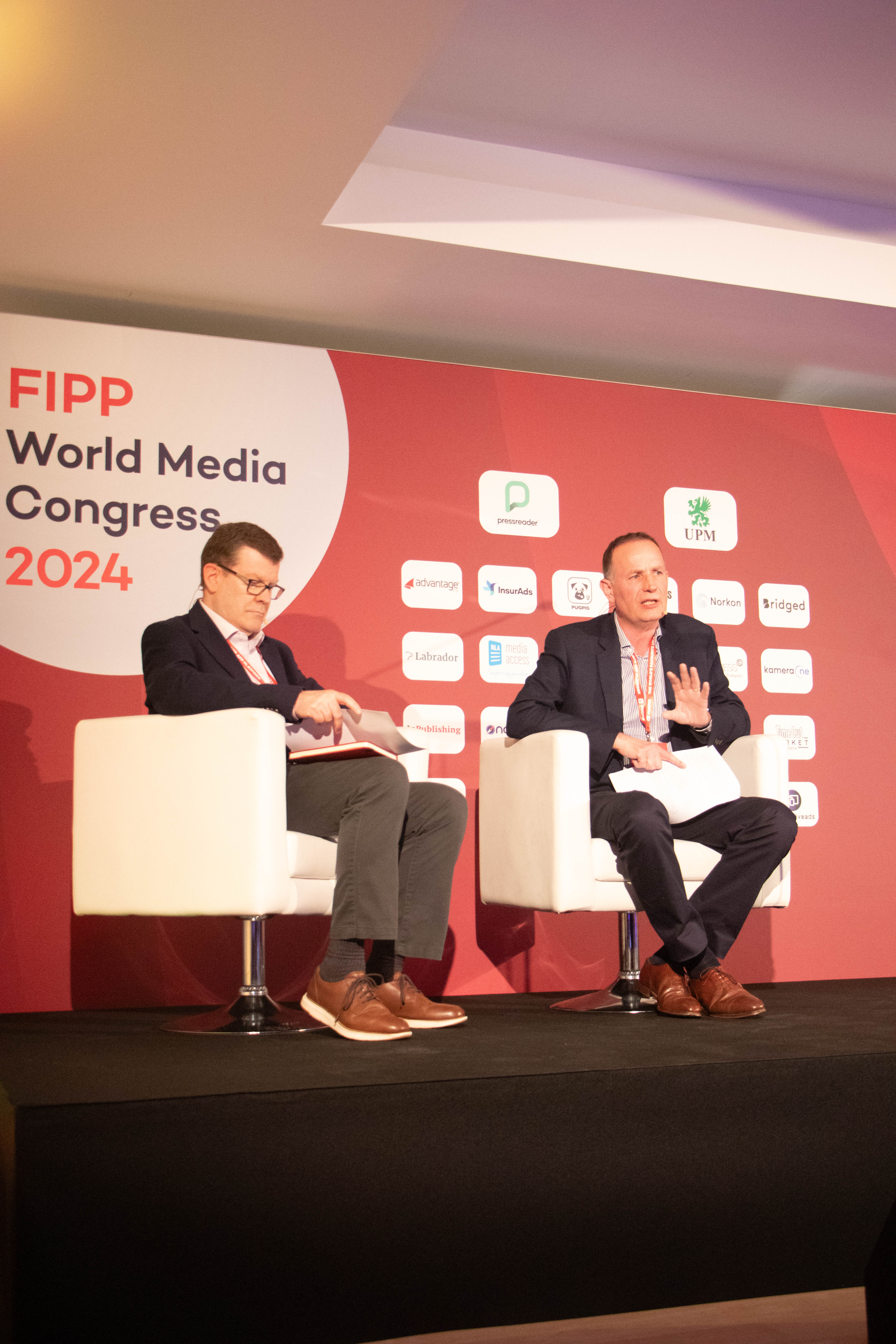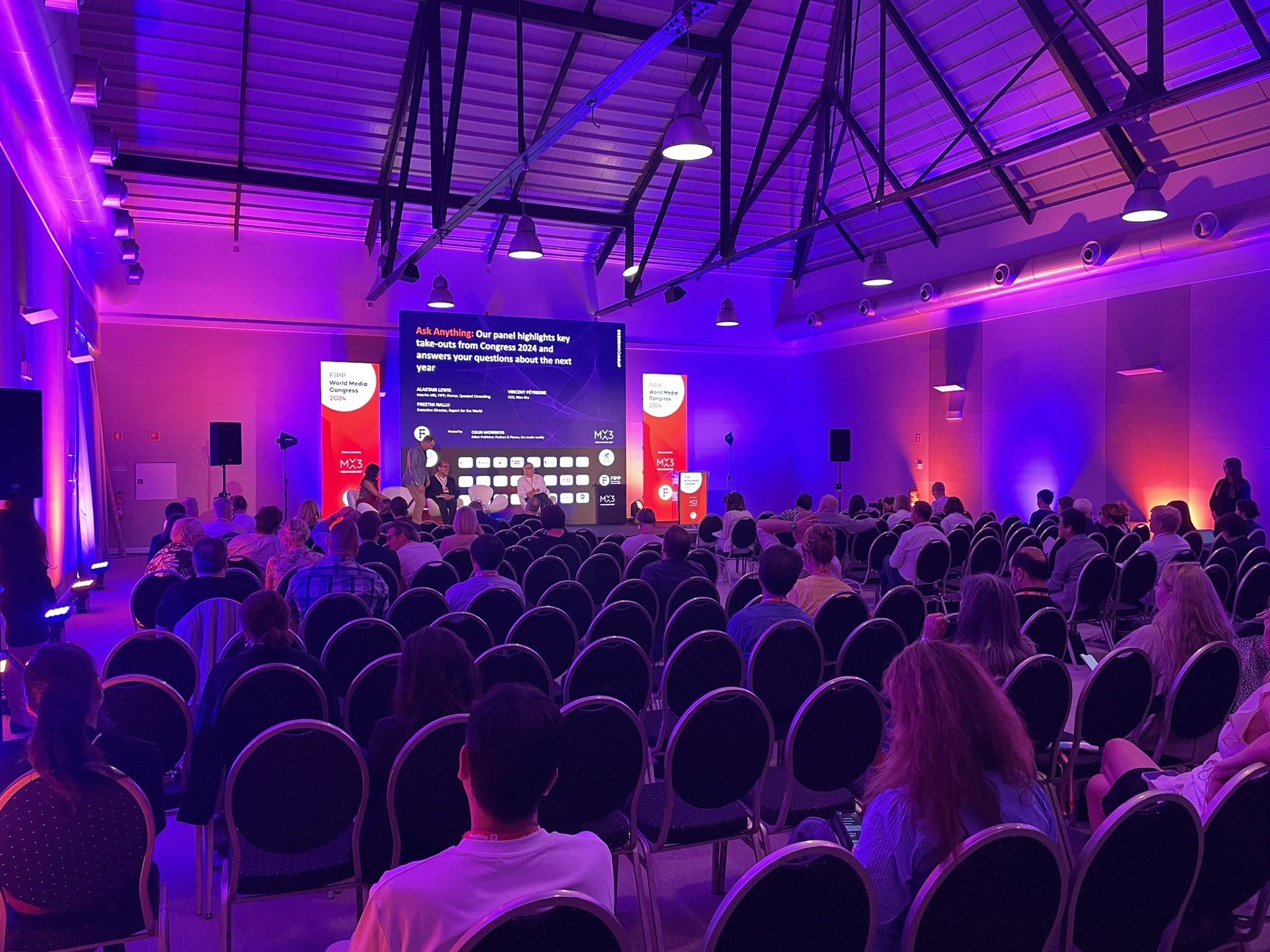The Digital Shift: Challenges & Solutions for Magazine Media
At the FIPP World Congress in Cascais, Portugal on 5 & 6 June 2024, Dan Heffernan, Vice President & Chief Product Manager, interviewed Philippe van Mastrigt, our Director of European Operations and Observer-in- Chief, about the impact of the digital shift on magazine media. Here is a transcription of this well-attended session, lightly edited for clarity. Full interview video can be found here.

Dan: For the past decade, newspapers have been in the spotlight for their digital transformation, from implementing paywalls like The New York Times in 2011, to building digital subscription models in 2016, with a boost during COVID, followed by a recent slowdown. However, magazines haven’t received as much attention. Why is that the case?
Philippe: First, it’s important to understand that the magazine industry’s business cycle has lagged behind that of newspapers. Newspapers saw a decline in print circulation as early as the ’70s and ’80s, whereas magazines had a golden age until the 2000s. While newspapers shifted to digital earlier, magazines stabilized print circulation and didn’t fully embrace digital. Both industries were hit hard by the digital shift around 2010, losing ad revenue to digital giants such as Google and Facebook. Newspapers adapted by transitioning to digital subscriptions, but magazines struggled to find a similar model. Instead, they experienced a slow decline in circulation and increased subscription and cover prices to offset the loss of ad revenue. Since 2022, magazines have been facing a crisis due to inflation – paper, printing, and distribution – and a rapid decline in circulation, with some experiencing annual drops of around 10%. Only recently has there been increased attention on magazines' digital strategies.
Secondly, the magazine industry covers numerous segments that all have unique challenges, so it is difficult to evaluate it as a whole. Weekly and daily newspapers are slowly transitioning online, while niche publications targeting people’s passions (hobbies, special interests, etc.) face competition from online sources such as blogs. Publications such as TV Guide, for example, are declining with the rise of alternative platforms.
Dan: What is the current situation of the magazine industry?
Philippe: Magazine circulation has been on a downward trend from 2010 to 2020. Some segments have disappeared, such as Computer Magazines in the United States (the last one closed in 2023), while others such as Reader’s Digest in the UK saw a significant decrease in subscribers from 1 million in 2001 to 100,000 in 2016 before closing. COVID temporarily paused this decline, with some publications, such as Dennis Publications titles, even seeing an increase in subscriptions. However, the inflation crisis of 2022 hit the industry hard, attributed to the rising costs of paper, printing, and distribution costs, along with other challenges. Among our clients, we observed an annual decrease of approximately 8% for the past two years.
Currently, we are witnessing a reorganization of magazine ownership and closures of titles that are not considered strong brands. In Germany, for example, RTL Group sold off a significant portion of its magazines, let go of 500 journalists, and announced that they would begin to focus on only strong core brands. Reworld Media has emerged as a new actor, acquiring Mondadori. Vivendi acquired Prisma, and Lagardère (formerly Hachette) publications were acquired by Vivendi and a new group, CMI. These new players often have disruptive strategies that focus on brands and digital advertising rather than traditional magazines, or they are simply seeking influence.
One concern that is shared with the newspaper industry is the possibility of an ecosystem collapse. In the UK, for example, there is only one large magazine printer remaining. Newsstands are disappearing rapidly across Europe, and distribution is also facing significant challenges due to increasing postal costs.
Given these trends, it is reasonable to anticipate a significant decrease in the magazine business in the next two years.

Dan: What are the specific challenges for magazines when it comes to digital?
Philippe: When mentioning “special challenges”, we should compare the situation with that of news publications.
I believe that the first challenge relates to the frequency of publishing, as magazines are typically published on a monthly, quarterly, and/or weekly frequency. However, in the digital age, consumers demand more frequent updates, sometimes daily. The question is: can magazine media sustain this frequency? This requires a substantial amount of journalism resources and topics that enable this pace to be viable.
In addition to frequency, another challenge is the reduction in exclusivity of content. For a long time, magazines were the primary source of specialized and exclusive content (in addition to books). However, much of this content is now available through other non-written formats. For example, we have a client that publishes magazines for primary school teachers. In recent years, this publisher has faced competition from teachers who are blogging similar content. As a result, subscriptions have decreased, and they have shifted their business model into downloads and book publishing. Furthermore, this trend is affecting other publications such as hobbymagazines, where tutorials on YouTube compete with traditional magazine content.
The last challenge I’ve observed is the nature of the format. As the magazine is a physical and tangible product, it offers that unique and more tactile reading experience that digital formats cannot replicate. For example, the presence of high-quality photos enhances the content, making it more engaging and enjoyable. Simply transitioning to a digital format, such as an e-paper, does not work well, and even if sales of digital formats are increasing, this doesn’t compensate for the loss of revenue due to print decreasing. Some magazines use aggregators as their main channel, such as Readly or Cafeyn, but this model often leads to lower revenue streams.
Dan: Are there any successful digital strategies emerging for magazines?
Philippe: Yes, it’s all about leveraging the value of a magazine’s brand, which is its greatest asset.
On the advertising front, several publishers have adopted new approaches to revive their business. For example, Dotdash Meredith in the US and Reworld Media in France have shifted away from the usage of cookies. Instead, Dotdash Meredith has developed a new strategy, which is based on consumer content consumption. By focusing on fast-loading sites, better content, and elimination of low-performing ads, they have increased their advertising sales. Reworld Media has also followed suit, leveraging its strong branding across various interests.
Meanwhile, there are effective strategies being developed around brand awareness on social networks. For example, the French magazine Gala has formed a strong presence on social media, especially TikTok, through short-form content. This has proven to be helpful in promoting brand awareness, particularly among young audiences, gaining 10 million followers on TikTok. Monetization of this audience is limited, but growing through brand content. In parallel, this social media strategy offsets the decline of the print version (which remains the flagship).
Another niche publication, Connaissance des Arts, has adopted a similar strategy: building a digital audience to support the brand, investing in the print edition, converting some of the digital audience into subscribers, and exploring other revenue streams (such as events). A similar example is Glamour, which anticipated the shift of advertising into the digital space and invested in digital while also maintaining their strong print presence, although decreasing its frequency to twice a year.

Dan: Many newspapers are envisioning the end of print, with some already making the switch. What about magazines? Is there a future for print?
Philippe: This question can be categorized into two possible directions: digital-only or digital-first.
I don’t see a long term future for “only-print” magazines, except perhaps niche ones, such as Monocle in the UK, which has a minimal online presence. I’ve noticed that when a magazine announces it is going all-digital, it typically means it’s in the process of shutting down. There are numerous instances of this. Therefore, maintaining a print edition is a positive sign of health for the brand.
Print offers distinct advantages: it is ideal for immersive reading and displaying photos, similar to books, which was one of the reasons for The Guardian’s launch of a print edition. As a physical object, print holds more value, and consumers are willing to pay more for that format. Many also appreciate the "digital detox" aspect, similar to how people enjoy books. Journalists often prefer to appear in print more than online, and some advertisers still prefer the printed format. In other words, print remains a valuable asset for the brand it supports. It is not surprising that some digital-only players have created a print magazine, while others, such as Life Magazine, recently reintroduced print versions.
However, the industry faces challenges, including the declining print ecosystem and a decrease in readership. Print magazines will need to adjust accordingly, possibly reducing the frequency of issues and aligning more with the book publishing model.
Dan: What do you think will be the model in the next five years?
Philippe: I believe it will be around leveraging the brand within its relevant segment of the market. On the subscription side, I expect to see more strategies where different products are bundled together and offered as a package, similar to how newspapers bundle print and digital editions. However, this approach will differ from the pure digital verticals we often see. For magazines, the subscription may offer access to various content, including print editions, as well as additional services related to content and partnerships with 3rd party brands. It’s the idea of creating a specific value proposition for subscribers that makes sense. This approach would also align well with content-based ad targeting, which is already growing and will possibly increase with increased privacy regulations.
I also anticipate that content commerce will continue to grow, building on the credibility of the brand.
Dan: What could happen that would put this at risk?
Philippe: One thing that is certain is that we are moving through a rocky landscape. I’ve mentioned the risks around a potential collapse of the print ecosystem, which would greatly impact the future. The changing reading habits, particularly among the younger generation, may be a significant challenge. The profound changes in the internet, including the impact of artificial intelligence on search, could also alter the landscape. Finally, publishers are facing an uncertain economic situation, and some may not have the resources necessary to survive the transition.
In other words, there is hope for the industry, but it won’t be easy.
Find full interview here :